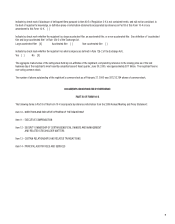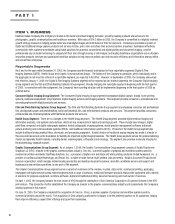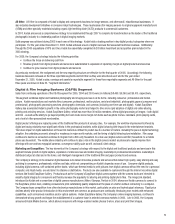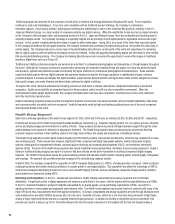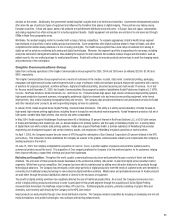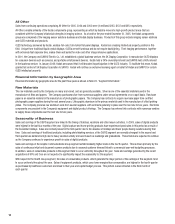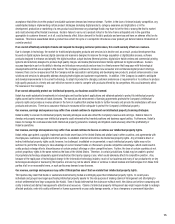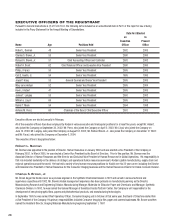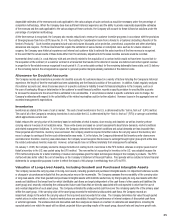Kodak 2005 Annual Report Download - page 19
Download and view the complete annual report
Please find page 19 of the 2005 Kodak annual report below. You can navigate through the pages in the report by either clicking on the pages listed below, or by using the keyword search tool below to find specific information within the annual report.17
of products, services and systems that Kodak offers, the large number of suppliers and contract manufacturers that are dispersed across the globe,
and the long lead times that are required to manufacture, assemble and deliver certain components and products, problems could arise in planning
production and managing inventory levels that could seriously harm Kodak. Other supplier problems that Kodak could face include component
shortages, excess supply and risks related to terms of its contracts with suppliers.
If our planned improvements in supply chain effi ciency are delayed, this could adversely affect our revenues and earnings.
As the Company continues with its transformation from a traditional products and services company to a digital products and services company,
Kodak’s planned improvement in supply chain effi ciency, if delayed, could adversely affect its business by preventing shipments of certain products to
be made in their desired quantities and in a timely and cost-effective manner. The planned effi ciencies could be compromised if Kodak expands into
new markets with new applications that are not fully understood or if the portfolio broadens beyond that anticipated when the plans were initiated.
Any unforeseen changes in manufacturing capacity could also compromise the supply chain effi ciencies.
The competitive pressures we face could harm our revenue, gross margins and market share.
Competition remains intense across all segments in which Kodak competes. In the D&FIS segment (which has been realigned into the Consumer
Digital Imaging Group and the Film and Photofi nishing Systems Group effective January 1, 2006), price competition has been driven somewhat by
consumers’ conservative spending behaviors during times of a weak world economy, international tensions and the accompanying concern over war
and terrorism. In the Health Group and Graphic Communications Group segments, aggressive pricing tactics intensifi ed in the contract negotiations as
competitors were vying for customers and market share domestically. If the Company is unable to obtain pricing or programs suffi ciently competitive
with current and future competitors, Kodak may lose market share, adversely affecting its revenue and gross margins.
If we fail to manage distribution of our products and services properly, our revenue, gross margins and earnings could be
adversely impacted.
The impact of continuing customer consolidation and buying power could have an adverse impact on Kodak’s revenue, gross margins, and earnings.
In the competitive consumer retail environment, there is a movement from small individually owned retailers to larger and commonly known mass
merchants. In the health market, there is a continuing consolidation of various group purchasing organizations. In the commercial graphic
communications market, the Company’s products are sold primarily through a variety of direct and indirect channels. These resellers and distributors
may elect to use suppliers other than Kodak. Kodak’s challenge is to successfully negotiate contracts that provide the most favorable conditions to the
Company in the face of price and aggressive competitors.
Economic uncertainty in developing markets could adversely affect our revenue and earnings.
Kodak conducts business in developing markets with economies that tend to be more volatile than those in the United States and Western Europe.
The risk of doing business in developing markets like China, India, Brazil, Argentina, Mexico, Russia and other economically volatile areas could
adversely affect Kodak’s operations and earnings. Such risks include the fi nancial instability among customers in these regions, political instability
and potential confl icts among developing nations and other non-economic factors such as irregular trade fl ows that need to be managed
successfully with the help of the local governments. Kodak’s failure to successfully manage economic, political and other risks relating to doing
business in developing countries and economically and politically volatile areas could adversely affect its business.
Because we sell our products and services worldwide, we are subject to changes in currency exchange rates and interest rates that may
adversely impact our operations and fi nancial position.
Kodak, as a result of its global operating and fi nancing activities, is exposed to changes in currency exchange rates and interest rates, which may
adversely affect its results of operations and fi nancial position. Exchange rates and interest rates in certain markets in which the Company does
business tend to be more volatile than those in the United States and Western Europe. There can be no guarantees that the economic situation in
developing markets or elsewhere will not worsen, which could result in future effects on earnings should such events occur.
Management has concluded that the Company did not maintain effective internal control over fi nancial reporting as of December 31,
2005 due to a material weakness in internal controls surrounding our accounting for income taxes. If we fail to remediate this material
weakness or any material weaknesses we may discover in the future, we may not be able to provide reasonable assurance regarding the
reliability of our fi nancial statements. As a result, our business, brand and operating results could be harmed.
Effective internal control over fi nancial reporting is necessary for the Company to provide reasonable assurance with respect to our fi nancial reports.
If the Company cannot provide reasonable assurance with respect to its fi nancial reports, its business, brand and operating results could be harmed.
As disclosed in the Company’s 2004 Annual Report on Form 10-K, and in its Quarterly Reports on Form 10-Q for each of the fi rst three quarters of
2005, management’s assessment of the Company’s internal controls over fi nancial reporting identifi ed material weaknesses in the Company’s
internal controls surrounding the accounting for income taxes and in its internal controls surrounding the accounting for pension and other
postretirement benefi t plans. In addition, in the Company’s Quarterly Report on Form 10-Q for the three and nine-month periods ended
September 30, 2005, the Company also reported a material weakness in its internal controls surrounding the preparation and review of spreadsheets


